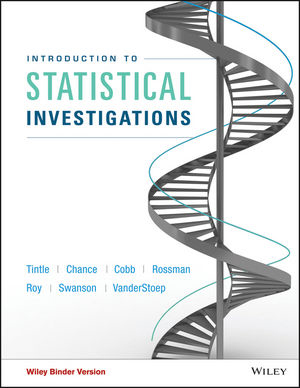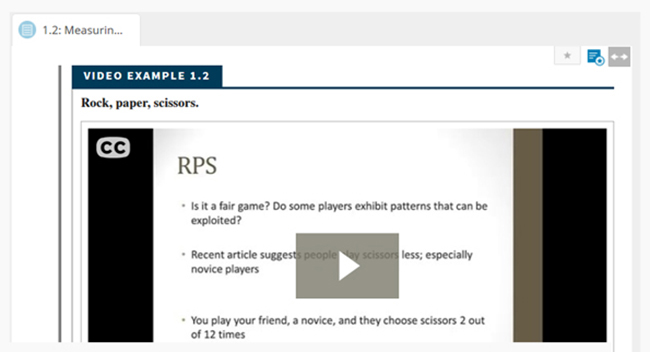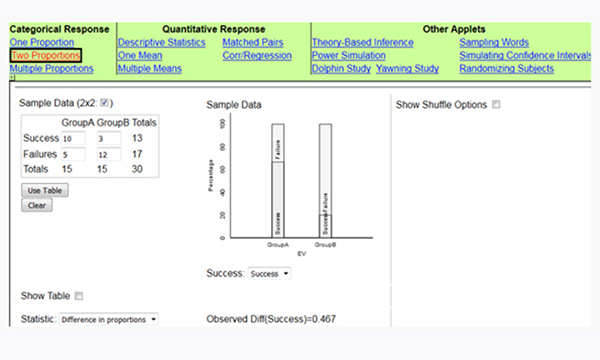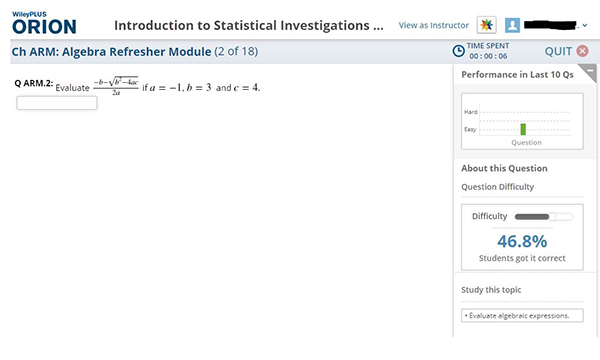
Introduction to Statistical Investigations
Nathan Tintle, Beth L. Chance, Soma Roy, George W. Cobb, Allan J. Rossman, Todd Swanson, and Jill VanderStoep
Introduction to Statistical Investigations is designed for a one-semester introduction to statistics course and follows the GAISE recommendations endorsed by the American Statistical Association. This course leads students to learn about the process of conducting statistical investigations from data collection to exploring data, to statistical inference, to drawing appropriate conclusions. A modern Simulations Based Inference (SBI) approach uses simulations and randomization tests to introduce statistical inference, yielding a strong conceptual foundation that bridges students to theory-based inference approaches.
The next generation of WileyPLUS for Introduction to Statistical Investigations gives instructors the freedom and flexibility to tailor content and easily manage their course to keep students engaged and on track.
Schedule a Demo Sign Up for a Test Drive Adopt WileyPLUSWant to learn more about WileyPLUS? Click Here

Author Videos enhance the learning experience.
A comprehensive series of approximately 200 Author Videos are included in WileyPLUS to aid in student comprehension throughout the program.

Students get hands-on practice with easy-to-use web applets.
ISI Applets enable students to conduct simulations and perform analyses (instructors may still use statistical software packages, if desired).

Adaptive practice module includes personalized study plan.
The Algebra Refresher Module gives students plenty of practice opportunities to master concepts prior to the course, which gives instructors more time to focus on progression during class.
- Wiley’s Enhanced E-Text: The benefits of this downloadable, reflowable eTextbook with added resources makes study time more effective. The Enhanced E-Text includes:
- Author Video Series
- Introduction to Statistics Applets
- Student Solutions Manual
- Spiral Approach to Statistical Process: A six-step process for conducting statistical investigations introduces students to the fundamental concept of statistical significance, along with collecting data and drawing conclusions.
- Active Learning Approach: Explorations in each chapter incorporate a variety of learning experiences such as shuffling cards, flipping coins, collecting data, running experiments, and using simulations. Explorations are flexible for individual student’s use or small to large groups, both in and outside class.
- Randomization-Based Introduction to Statistical Inference. This approach makes use of modern computing and puts the logic of statistical inference at the center of the curriculum.
- Easy-to-Use Technology: Web applets enable students to conduct simulations and perform analyses (instructors may still use statistical software packages, if desired).
- Real Data from Genuine Studies. Real data from genuine research studies is incorporated throughout, taken from a variety of fields of application.
- Focus on Logic and Scope of Inference. Students are asked to consider questions of logic and scope of inference for every study encountered in the text.
What’s New
Introduction to Statistical Investigations enhancements include:

Nathan L. Tintle is associate professor of statistics at Dordt College. He has led efforts to develop and institutionalize randomization-based curricula at two institutions (Hope College, 2005–2011 and Dordt, 2011–present), and currently leads the curriculum development project. He has been an invited panelist for several statistics education sessions at national meetings, was recently a member of the executive committee of the Section of Statistical Education of the ASA, received the 2013 Waller Education Award for teaching and innovation in introductory statistics, and was a member of a national advisory committee to the ASA President on training the next generation of statisticians. He has co-authored several articles on student learning using the randomization curriculum, one of which recently won an award for best paper of the year from the Journal of Statistics Education.
Beth L. Chance is professor of statistics at California Polytechnic State University. She is co-author with Allan Rossman of the Workshop Statistics series and Investigating Statistical Concepts, Applications, and Methods. She has published articles on statistics education in The American Statistician, Journal of Statistics Education, and the Statistics Education Research Journal. She has also collaborated on several chapters and books aimed at enhancing teacher preparation to teach statistics and has been involved for many years with the Advanced Placement Statistics program. She is a Fellow of the American Statistical Association and received the 2002 Waller Education Award for Excellence and Innovation in Teaching Undergraduate Statistics. The Rossman/Chance collection of online applets for exploring statistical concepts was awarded the 2009 CAUSEweb Resource of the Year Award and a 2011 MERLOT Award for Exemplary Learning Materials.
Soma Roy is associate professor of statistics at California Polytechnic State University. She is editor of the Journal of Statistics Education and has presented talks related to the randomization-based curriculum and student learning at national meetings. She writes and reviews assessment tasks for the Illustrative Mathematics Project, an initiative to support adoption of the K-12 core standards for statistics. She co-leads, with her colleagues at Cal Poly, a teacher-preparation workshop for AP Statistics teachers. She also has an active research program in health statistics involving undergraduates.
George W. Cobb is Robert L. Rooke Professor Emeritus of Statistics at Mount Holyoke College and has extensive knowledge of statistics education, expertise in developing imaginative and innovative curricular materials, and the honor of having brought the conversation on randomization-based approaches in introductory statistics to the mainstream via his 2005 USCOTS presentation and 2007 paper. He served as the first chair of the Joint Committee on Undergraduate Statistics of the American Mathematical Association and American Statistical Association (1991–1998), editing that committee’s 1992 report, “Teaching Statistics.” He served for three years on the National Research Council’s Committee on Applied and Theoretical Statistics and recently served as vice president of the American Statistical Association. He is a fellow of the ASA and received the ASA’s Founders Award in 2007. He has published and edited several books.
Allan J. Rossman is professor and chair of the statistics department at California Polytechnic State University. He earned a Ph.D. in Statistics from Carnegie Mellon University. He is co-author with Beth Chance of the Workshop Statistics series and Investigating Statistical Concepts, Applications, and Methods, both of which adopt an active learning approach to learning introductory statistics. He served as program chair for the 2007 Joint Statistical Meetings, as president of the International Association for Statistical Education from 2007 to 2009, and as chief reader for the Advanced Placement program in statistics from 2009 to 2014. He is a fellow of the American Statistical Association and received the Mathematical Association of America’s Haimo Award for Distinguished College or University Teaching of Mathematics in 2010.
Todd M. Swanson is associate professor of mathematics at Hope College. He is a co-author of Precalculus: A Study of Functions and their Applications, Understanding Our Quantitative World and Projects for Precalculus, which was an INPUT Award winner. He has published articles in the Journal of Statistics Education, Statistics Education Research Journal, and Stats: The Magazine for Students of Statistics. He has presented at numerous national meetings, workshops, and mini-courses about innovative ways to teach mathematics and statistics that focus on guided-discovery methods and projects.
Jill L. VanderStoep is adjunct assistant professor of mathematics at Hope College. She has participated in efforts to develop and implement randomization-based curricula at Hope College since 2005. She has presented on the curriculum and assessment results at national conferences and has co-led workshops on introducing and implementing the randomization-based curriculum. She has co-authored two articles looking at student learning differences between randomization-based curriculum and traditional curriculum. She has extensive experience in the evaluation of assessment data to drive curricular reform.
P. Preliminaries: Introduction to Statistical Investigations
P.1 Introduction to the Six-Step Method
P.2 Exploring Data
P.3 Exploring Random Processes
Unit 1: Four Pillars of Inference: Strength, Size, Breadth, and Cause
1.0 Significance: How Strong Is the Evidence?
1.1 Introduction to Chance Models
1.2 Measuring the Strength of Evidence
1.3 Alternative Measure of Strength of Evidence
1.4 What Impacts Strength of Evidence?
1.5 Inference for a Single Proportion: Theory-Based Approach
2.0 Generalization: How Broadly Do the Results Apply?
2.1 Sampling from a Finite Population
2.2 Inference for a Single Quantitative Variable
2.3 Errors and Significance
3.0 Estimation: How Large is the Effect?
3.1 Statistical Inference: Confidence Intervals
3.2 2SD and Theory-Based Confidence Intervals for a Single Proportion
3.3 2SD and Theory-Based Confidence Intervals for a Single Mean
3.4 Factors that Affect the Width of a Confidence Interval
3.5 Cautions When Conducting Inference
4.0 Causation: Can We Say What Caused the Effect
4.1 Association and Confounding
4.2 Observational Studies Versus Experiments
Unit 2: Comparing Groups
5.0 Comparing Two Groups
5.1 Comparing Two Groups: Categorical Response
5.2 Comparing Two Proportions: Simulation-Based Approach
5.3 Comparing Two Proportions: Theory-Based Approach
6.0 Comparing Two Means
6.1 Comparing Two Groups: Quantitative Response
6.2 Comparing two Means: Simulation-Based Approach
6.3 Comparing Two Means: Theory-Based Approach
7.0 Paired Data: One Quantitative Variable
7.1 Paired Designs
7.2 Analyzing Paired Data: Simulation-Based Approach
7.3 Analyzing Paired Data: Theory-Based Approach
Unit 3: Analyzing More General Situations
8.0 Comparing More Than Two Proportions
8.1 Comparing Multiple Proportions: Simulation-Based Approach
8.2 Comparing Multiple Proportions: Theory-Based Approach
9.0 Comparing More Than Two Means
9.1 Comparing Multiple Means: Simulation-Based Approach
9.2 Comparing Multiple Means: Theory-Based Approach
Unit 4: Two Quantitative Variables
10.1 Two Quantitative Variables: Scatterplots and Correlation
10.2 Inference for the Correlation Coefficient: Simulation-Based Approach
10.3 Least Squares Regression
10.4 Inference for the Regression Slope: Simulation-Based Approach
10.5 Inference for the Regression Slope: Theory-Based Approach
A: Calculation Details
B: Stratified and Cluster Samples
Solutions to Selected Exercises
Index

